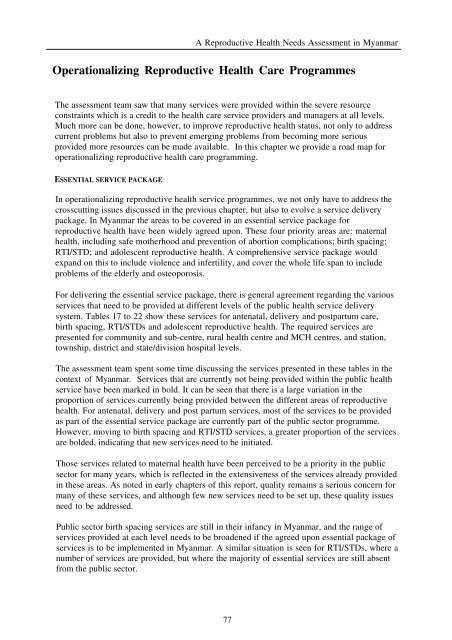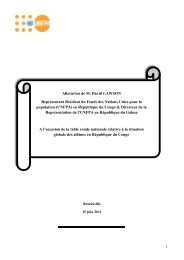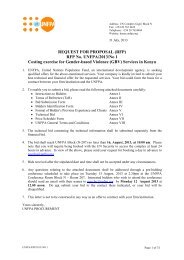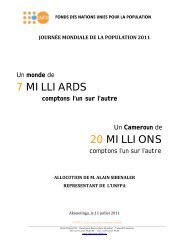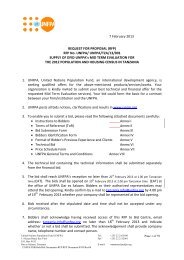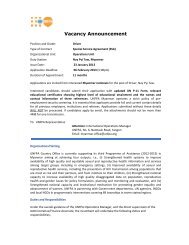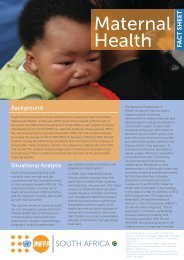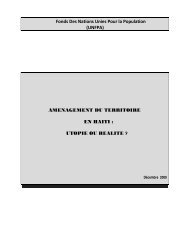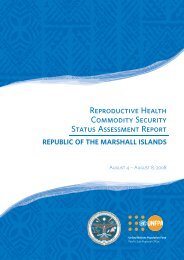A reproductive health needs assessment in Myanmar
A reproductive health needs assessment in Myanmar
A reproductive health needs assessment in Myanmar
You also want an ePaper? Increase the reach of your titles
YUMPU automatically turns print PDFs into web optimized ePapers that Google loves.
A Reproductive Health Needs Assessment <strong>in</strong> <strong>Myanmar</strong><br />
Operationaliz<strong>in</strong>g Reproductive Health Care Programmes<br />
The <strong>assessment</strong> team saw that many services were provided with<strong>in</strong> the severe resource<br />
constra<strong>in</strong>ts which is a credit to the <strong>health</strong> care service providers and managers at all levels.<br />
Much more can be done, however, to improve <strong>reproductive</strong> <strong>health</strong> status, not only to address<br />
current problems but also to prevent emerg<strong>in</strong>g problems from becom<strong>in</strong>g more serious<br />
provided more resources can be made available. In this chapter we provide a road map for<br />
operationaliz<strong>in</strong>g <strong>reproductive</strong> <strong>health</strong> care programm<strong>in</strong>g.<br />
ESSENTIAL SERVICE PACKAGE<br />
In operationaliz<strong>in</strong>g <strong>reproductive</strong> <strong>health</strong> service programmes, we not only have to address the<br />
crosscutt<strong>in</strong>g issues discussed <strong>in</strong> the previous chapter, but also to evolve a service delivery<br />
package. In <strong>Myanmar</strong> the areas to be covered <strong>in</strong> an essential service package for<br />
<strong>reproductive</strong> <strong>health</strong> have been widely agreed upon. These four priority areas are: maternal<br />
<strong>health</strong>, <strong>in</strong>clud<strong>in</strong>g safe motherhood and prevention of abortion complications; birth spac<strong>in</strong>g;<br />
RTI/STD; and adolescent <strong>reproductive</strong> <strong>health</strong>. A comprehensive service package would<br />
expand on this to <strong>in</strong>clude violence and <strong>in</strong>fertility, and cover the whole life span to <strong>in</strong>clude<br />
problems of the elderly and osteoporosis.<br />
For deliver<strong>in</strong>g the essential service package, there is general agreement regard<strong>in</strong>g the various<br />
services that need to be provided at different levels of the public <strong>health</strong> service delivery<br />
system. Tables 17 to 22 show these services for antenatal, delivery and postpartum care,<br />
birth spac<strong>in</strong>g, RTI/STDs and adolescent <strong>reproductive</strong> <strong>health</strong>. The required services are<br />
presented for community and sub-centre, rural <strong>health</strong> centre and MCH centres, and station,<br />
township, district and state/division hospital levels.<br />
The <strong>assessment</strong> team spent some time discuss<strong>in</strong>g the services presented <strong>in</strong> these tables <strong>in</strong> the<br />
context of <strong>Myanmar</strong>. Services that are currently not be<strong>in</strong>g provided with<strong>in</strong> the public <strong>health</strong><br />
service have been marked <strong>in</strong> bold. It can be seen that there is a large variation <strong>in</strong> the<br />
proportion of services currently be<strong>in</strong>g provided between the different areas of <strong>reproductive</strong><br />
<strong>health</strong>. For antenatal, delivery and post partum services, most of the services to be provided<br />
as part of the essential service package are currently part of the public sector programme.<br />
However, mov<strong>in</strong>g to birth spac<strong>in</strong>g and RTI/STD services, a greater proportion of the services<br />
are bolded, <strong>in</strong>dicat<strong>in</strong>g that new services need to be <strong>in</strong>itiated.<br />
Those services related to maternal <strong>health</strong> have been perceived to be a priority <strong>in</strong> the public<br />
sector for many years, which is reflected <strong>in</strong> the extensiveness of the services already provided<br />
<strong>in</strong> these areas. As noted <strong>in</strong> early chapters of this report, quality rema<strong>in</strong>s a serious concern for<br />
many of these services, and although few new services need to be set up, these quality issues<br />
need to be addressed.<br />
Public sector birth spac<strong>in</strong>g services are still <strong>in</strong> their <strong>in</strong>fancy <strong>in</strong> <strong>Myanmar</strong>, and the range of<br />
services provided at each level <strong>needs</strong> to be broadened if the agreed upon essential package of<br />
services is to be implemented <strong>in</strong> <strong>Myanmar</strong>. A similar situation is seen for RTI/STDs, where a<br />
number of services are provided, but where the majority of essential services are still absent<br />
from the public sector.<br />
77


